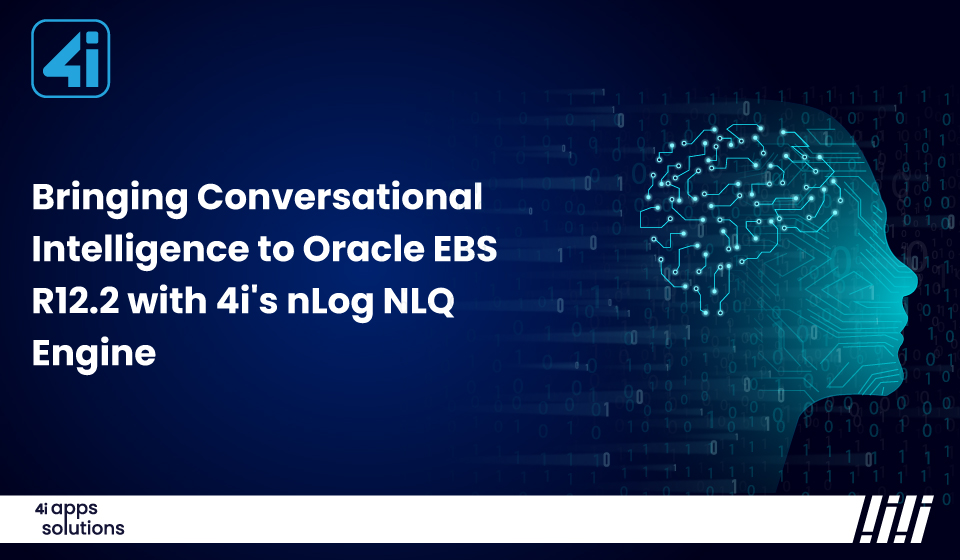blogs / Oracle E-Business Suite
Bringing Conversational Intelligence to Oracle EBS R12.2 with 4i’s nLog NLQ Engine
In today’s data-driven enterprises, speed and simplicity in accessing insights can be a game-changer. With 4i’s nLog Natural Language Query (NLQ) engine, users of Oracle E-Business Suite (EBS) R12.2 can now interact with business data using everyday English. No SQL, no technical barriers—just smart, fast access to answers.
This guide walks you through how to integrate nLog into Oracle EBS using APEX, Oracle Autonomous Database, and REST services. Think of it as giving your ERP system a brain that speaks your language—literally.
What Is NLQ and Why Does It Matter?
nLog, developed by 4i, brings a conversational layer to Oracle EBS. Ask things like, “What are last month’s sales figures for Region X?” and nLog will translate it into the right query in real time. Unlike static dashboards, nLog understands context, user roles, and domain-specific terms—making data more accessible to everyone.
Related Terms: nLog NLQ engine, Oracle EBS NLQ integration, natural language interface for ERP.
Prerequisites for Enabling nLog in Oracle EBS R12.2
Before we dive into the setup, ensure your environment is ready:
- Oracle E-Business Suite Release 12.2.7 or later
- Oracle Application Framework (FWK) Patch 36839803
- Oracle Database Release 19c or later
- Oracle APEX 24.1 or later
- Oracle REST Data Services (ORDS) 24.3 or later
- Apache Tomcat 9 or later
- Oracle OCI Autonomous Database Release 19c or later
For EBS instances prior to R12.2.14, apply these patches:
- R12.AD.C.Delta.16
- R12.TXK.C.Delta.16
- R12.ATG_PF.C.Delta.13
Quick Check:
SELECT release_name FROM fnd_product_groups; — Should return 12.2.7+
SELECT bug_number FROM ad_bugs WHERE bug_number = ‘36839803’; — Confirms FWK patch
How nLog Enhances Oracle EBS
While Oracle EBS remains the core ERP system, nLog serves as the intelligent NLQ layer on top. By integrating with APEX and Oracle’s secure backend, nLog delivers:
- Context-aware query resolution
- Pre-trained domain ontologies for modules like Financials, SCM, and Manufacturing
- Fine-tuned language understanding based on your business terminology
- Adaptive learning with usage over time
With nLog, NLQ is not just functional—it’s insightful.
Step 1: Downloading the nLog Integration Package
Access the latest nLog EBS integration build from 4i’s customer portal or contact your 4i consultant. The zip includes the nLog APEX app, PL/SQL policies, view templates, and REST setup scripts.
Unzip the contents to your EBS server:
cd /u02/EBS_NLQ/
unzip nLog_EBS_Code_YYYYMMDD.zip
Step 2: Configuring the Autonomous Database
The OCI Autonomous Database powers nLog’s backend, handling query translation with LLM-based understanding. Your OCI team will provide:
- Database URL
- OAuth Client ID and Secret
Tip: Keep these credentials safe for later configuration.
Step 3: Configuring Oracle E-Business Suite
3.1 Create an XX_NLQ Schema
sqlplus / as sysdba
ALTER SESSION SET CONTAINER = test;
CREATE USER xx_nlq IDENTIFIED BY xx_nlq;
GRANT CREATE SESSION TO xx_nlq;
3.2 Register the XX_NLQ Schema with EBS
cd /nfsmount/apps/
. EBSapps.env RUN
sqlplus apps/apps @ $AD_TOP/patch/115/sql/ADAPEXSCHREG.sql XX_NLQ
3.3 Create Database Artifacts
cd /u02/EBS_NLQ/nLog_EBS_Code/ebs/scripts/
sqlplus apps/apps
@nlq_views.sql
@nlq_secret_functions.sql
@nlq_upd_policies.sql
@nlq_permissions.sql
@nlq_ebs_profile.sql
Step 4: Configuring Oracle APEX
4.1 Deploy Oracle APEX Platform
Confirm APEX version:
SELECT version_no FROM apex_release; — Should return 24.1.0+
4.2 Create an APEX Workspace
- Workspace: EBS_NLQ APEX
- Schema: XX_NLQ
4.3 Install the nLog APEX Interface
- In App Builder > Import > Upload nLog APEX app > Install.
4.4 Configure Network Access Control
BEGIN
DBMS_NETWORK_ACL_ADMIN.APPEND_HOST_ACE(
host => ‘your-autonomous-db-host’,
lower_port => 443,
ace => xs$ace_type(
privilege_list => xs$name_list(‘http’),
principal_name => apex_application.g_flow_schema_owner,
principal_type => xs_acl.ptype_db
)
);
END;
/
4.5 Configure Database Wallet
cd /u02/EBS_NLQ/certificate/
orapki wallet add -wallet /u02/EBS_NLQ/certificate -trusted_cert -cert root.crt
4.6 Link Wallet in APEX Admin
- Path: file:/u02/EBS_NLQ/certificate
4.7 Create APEX Web Credential
- Name: nLog OAuth Credential
- Client ID/Secret: Use OCI values
- Valid URLs: Include ORDS base URL
4.8 Update Application Settings
- Set ADB_REST_BASE_URL to your ORDS URL (e.g., https://your-adb-url/ords/)
4.9 Configure HTTP Response Headers
Content-Security-Policy: frame-ancestors ‘self’ http://your-ebs-domain:port;
Step 5: Integrating APEX with E-Business Suite
5.1 Define the EBS Profile
Set profile FND: APEX URL to http://your-apex-server:port/ords
5.2 Create a Form Function
- Name: Ask Oracle E-Business Suite (EBS)
- Code: XX_NLQ_APEX_ASK_ORCL
- Type: Apex
- Workspace: EBS_NLQ APEX
- Application: nLog Natural Language Query
5.3 Update Menu
- Add to menu (e.g., MFG_DISTSUPERUSER_GUI):
- Prompt: Ask Oracle E-Business Suite (EBS)
- Function: Ask Oracle EBS
Step 6: Configuring Security
6.1 Verify Permissions
Search for “EBS_NLQ%” in Functional Administrator > Security > Permissions.
6.2 Define Permission Sets
- Name: nLog Permission Set for Discrete Manufacturing
- Code: XX_NLQ_DMF_PS
6.3 Create Roles and Grants
- Role Code: UMX|XX_NLQ_DMF_ROLE
- Name: nLog Role for Discrete Manufacturing
- Link to Permission Set
6.4 Assign Roles to Users
Via User Management UI.
Functional Overview of nLog in Oracle EBS
Once integrated, users can query Oracle EBS using natural language via APEX:
“Show inventory levels for Product X”
nLog translates this into context-aware SQL and returns results instantly.
Case Study: A leading Middle East manufacturing group deployed nLog with Oracle EBS, achieving a 30% drop in report turnaround time and reducing dependence on IT by 40% for operational queries.
Conclusion
With 4i’s nLog, Oracle EBS gets a conversational upgrade—transforming how users interact with enterprise data. This guide has shown you how to integrate nLog within your existing Oracle stack using APEX and Autonomous DB.
Call to Action: Ready to simplify enterprise reporting? Contact 4i for a demo or sandbox setup.







